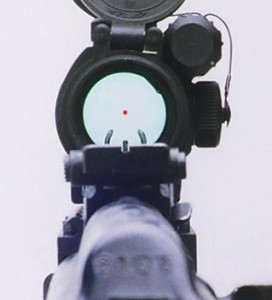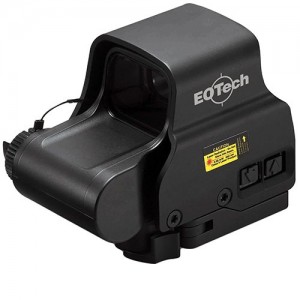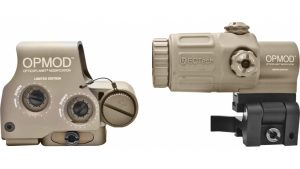It seems that an AR-15 and a red dot sight go hand in hand…if they had hands. When I finished building my AR, the first thing I did was to start pricing red dots (also called “reflex sights”). The problem is that you can’t just walk into a store and say “I’d like a red dot sight, please.” That’s kind of like walking into a wine store and saying “I’d like a bottle of wine.”
When I started looking, there were all kinds of terms and styles and I had no idea which was best. So I hopped on the internet to see what I could find out. Do you have any idea how difficult it is to find information on red dot sights that isn’t specifically referring to the Call of Duty or Battlefield video games? It was almost impossible.

It’s been a long journey trying to get this article together. I don’t write anything without researching it, even if it’s something I already feel like I know well enough. Often times, during my research, I would stumble on to what seemed like a great reference only to spot “so I’d recommend a holographic for multiplayer” in the very last paragraph. After sorting through the junk as well as speaking with some actual experts at SHOT Show, I’ve come up with the following information.
Can’t wait and just want to see our recommended sights? Check out our AR-15 Scopes & Optics Guide.
What is a Red Dot Sight?
It’s a sight for your gun that employs a holographic red dot. That’s not sarcasm, I just couldn’t think of a better way of saying it. You notice that I didn’t say “scope.” These are not scopes. These are to be used in place of, or preferably along with your iron sights. They are used for the same reason and parameters as your iron sights.
How Do Red Dot Sights Work?

Depending on the type of sight you go with, the details of how they work will change a bit but ultimately it works off of the “Pepper’s Ghost” concept. According to Wikipedia, Pepper’s Ghost is “an illusionary technique used in theatre, haunted house, dark rides and in some magic tricks”. There’s a good chance you’ve seen this effect and never realized it.

Essentially, using a plate of glass and some creative lighting, you can make objects disappear or morph into other objects. A person slowly turning into a skeleton, for example. Basically, the glass will reflect when the lights are shining on one side, hiding what’s behind the glass. Then, when the lights out front are lower and the lights behind are brought up, the glass stops reflecting and just shows what’s behind it.
The red dot works pretty much the exact way. A slightly angled piece of glass reflects the light from an LED on to it. Because of the brightness of the LED bulb, you’re going to see that dot regardless of how bright your surroundings.
Why Do I Want One?
So why would anyone want a red dot sight? Well, by the very nature of how it works, the location of the dot corrects itself (up to a point). When you’re looking through the sights, regardless of what angle you’re looking at (again, up to a point), the dot will move to cover the target. Because of that auto-correcting nature, it allows you to keep both eyes open which makes for better awareness of your surroundings and, ultimately, allows you to find your target and get the sight on it faster (also known as “target acquisition”).

Red dot sights aren’t limited to AR-15 and AK-47 rifles either. You can find them often on handguns and even shotguns. They’re great for home defense pistols but not so much for concealed carry, mind you, because of the bulkiness they add. Competition shooters usually use them whenever the rules allow for it because that fast target acquisition can shave seconds off their stage time.
Co-Witness
If you’re using a red dot sight along with iron sights, you might want to “co-witness” them. The actual definition is a bit vague but ultimately it means to line up your red dot with your iron sights so they both point at the same place. There’s various reasons why you would want to do this.
For starters, it’s a good backup in the off chance that the red dot sight fails. As much as we don’t want to think about it, a red dot sight is still an electronic component and electronics can and do fail from time to time. While the power they consume is very small, the battery will die at some point and Murphy’s Law says it will die when you need it the most. That’s usually the main argument for co-witnessing. Keep in mind that there’s two types of co-witnessing (absolute and lower 1/3) depending on personal preference. I prefer lower 1/3 so the irons aren’t in the way as much during normal red dot use.

If you zero your red dot and your iron sights separately, you can use co-witnessing as a way to verify you zeroed correctly. Finally, it provides a quick way to verify that your sights haven’t moved. Co-witnessing might not be possible, however, depending on your gun’s configuration. It never hurts to try though.
Different Types of Red Dot Sights
Red Dot Sight (Reflex)

First off is the style usually just labelled as “red dot sight” or “reflex sight”. This is a tube with no magnification to it and the components are all contained inside that tube. A good example are Aimpoint variants. Because everything is housed inside of a protective shell, these are usually rather sturdy. The lenses are usually recessed so they’re not going to get scratched up by limbs and such. They also seem to stand up to getting banged around a bit more, which is logical considering their design. The down side is that the range of angles is restricted. While you can keep both eyes open, you still have to have a good cheek weld to be able to see the dot.
Holographic Sights

If you’re looking to shoot from wider angles, say from behind cover in a competition or home defense scenario, a “holographic red dot sight” is probably the option you want. Their inner-workings are slightly different from regular red dot sights but the end result is very similar. In this configuration, the components are housed in a base and just a piece of glass and a frame sticks up. EOTech is most well known for this style. On the plus side, you get a much better field of view and, because the glass is larger, you can use it at more extreme angles. On the down side, the components aren’t as protected. That’s not to say the holographic sights are flimsy, mind you. The military uses EOTech sights in combat. They wouldn’t do that with some flimsy piece of cardboard.
The reticles are also different for red dots and EOTech holographic sights. A lot of personal preference here since some like the simplicity of a single red dot, while others like the larger circle of the EOTech for closer encounters.

ACOG Sights

Finally, we come to the Advanced Combat Optical Gunsights or ACOG, for those of you that are into that whole brevity thing. These are for when you want to reach out and touch your target. ACOG sights have magnification so that you can hit targets at longer distances. They’re not made for extreme distances, however, so if that’s your goal then a standard scope is the better choice for you. This is essentially to bridge the gap between iron sights and a scope. While there are some copies of the style, ACOG sights are exclusively built by Trijicon as the term ACOG is their trademark. These have the same strengths as the standard red dot sights in that they’re a bit sturdier in design but you get the added bonus of being able to hit targets farther away. The down side is that these aren’t made for shooting up close. Some ACOG sights come with a holographic sight mounted on top to overcome this problem. You also can’t co-witness with an ACOG.
I Can See Clearly Now

If you like the long distance ability of the ACOG but don’t want to give up your close quarters abilities, there are magnifiers available for the other styles. Both EoTech and Aimpoints, for example, offer a magnifier that flips over in front so that you switch between long distance and close quarters in a snap.
Ouch, My Wallet…
And now for the down side: these aren’t cheap. I know you saw that guy selling unbranded or obscurely branded red dot sights (probably in green boxes) for under $50 at your last gun show. Take it from me: don’t give in to temptation. Unless you just went crazy with the components when you pieced your gun together, there’s a good chance that the red dot sight is going to be one of the most expensive parts on your gun.
All in all, a good red dot sight is a great addition to your gun and well worth the money. I love mine and I’ve yet to talk with anyone who didn’t love using them. Most of all, make sure you practice with it if you do get one.
Of course, we’ve got you covered with our Best Scopes & Optics Guide.
Learning Resources
Beginner’s Guide to GunsThe post All About Red Dot Sights appeared first on Pew Pew Tactical.